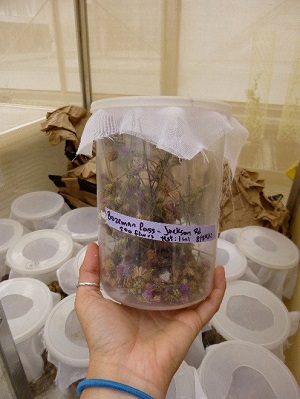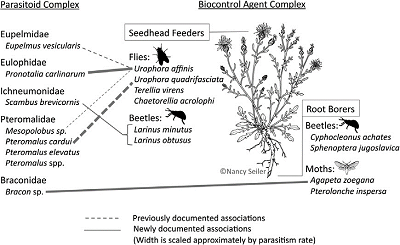Enemy of the enemy: Native parisitoids associated with knapweed biocontrols- November 2015
Download this weed post on native parisitoids associated with knapweed biocontrols as a PDF
Under classical biological control, agents are released against target non-native weeds under the assumption that the weed is successful in its invaded range due to the lack of natural enemies. During importation and release of a new biocontrol agent, measures are taken to ensure that the agent is free of parasitoids.

Parasitoids are insects that have a life stage that develops on or within a single insect host, ultimately killing the host. The screening of biocontrol agents to ensure they are free of parasitoids is important because agents in their introduced range are more likely to be effective in areas where their own natural enemies are absent. Unfortunately, biocontrol agents may not remain enemy-free because introduced organisms can become prey to parasitoids that are native in the new environment.
Studies conducted in South Africa and New Zealand have shown that attack of introduced biocontrol agents by native parasitoids is common and can inhibit success of the agent in achieving control of a pest. Parasitism of weed biocontrol agents in the U.S. has been reported in numerous cases, including agents released for control of non-native thistles, yellow starthistle, rush skeletonweed, and spotted knapweed.
Biological control of spotted knapweed began in the 1970s, and since that time 13 agents have been released. Relatively little is known about parasitoids attacking spotted knapweed biocontrol agents in their introduced range and the degree to which they may limit biocontrol efficacy. Parasitism is highly likely, however, given that these agents have been present for decades and such relationships usually take time to develop. Seven studies investigating parasitism of spotted knapweed biocontrol agents have been published and all were focused on seedhead-feeding Urophora flies, the earliest agents released. Given the limited scope of previous work and the potential impact to biocontrol efficacy, we believed further research was warranted.

We conducted a study to identify parasitoids attacking spotted knapweed biocontrol agents in Montana and determine the percent parasitism of any host-parasitoid associations found. Roots and seedheads of spotted knapweed were collected from 45 sites in western Montana over a two-year period, and monitored for insect emergence (photo, right). Of the 13 biocontrol agents released against spotted knapweed, 10 were reared from plant material collected. Nine species of parasitoids emerged, four of which were previously unknown associations with these biocontrol agents (see figure, right). Host associations were determined for three of the parasitoid species, and others were inferred based on previous studies. Parasitism rates of Urophora affinis were surprisingly high, reaching 100% in some cases. The long-term vulnerability of biocontrol agents to parasitism by native organisms is a concern for the practice of classical biological control, especially for agents that have been established for several decades, and thus merits further research attention.
Read about this study in more detail. This study was supported by a grant from USDA-National Institute of Food and Agriculture (#2012-67014-19365).
